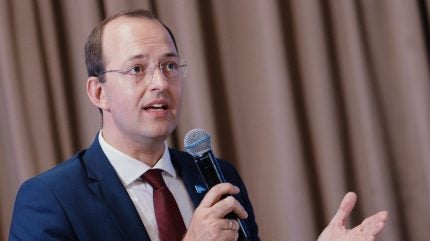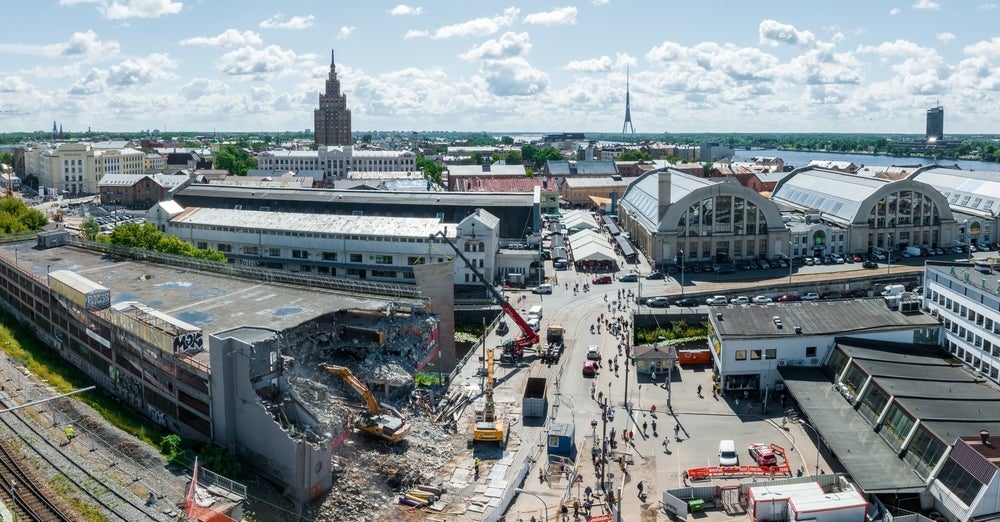
Two years on from Russia’s invasion of Ukraine, many voices at last week’s Three Seas Initiative Business Forum were emphasising the importance of security in the region. One piece in the puzzle that is at the core of the annual event, which draws together 13 European nations and their partners, is Rail Baltica – an infrastructure project to integrate the Baltics into the European rail network.
Termed the ‘project of the century’, Rail Baltica is aimed at facilitating high-speed train travel between Tallinn in Estonia, Warsaw in Poland, and Vilnius in Lithuania.
“It takes nine hours to reach Warsaw from Vilnius by railway,” Lithuania’s Minister of Transport and Communication Marius Skuodis told Railway Technology at the forum. “It’s nonsense. So, we’re doing a lot to change the situation.”
Skuodis, speaking following his moderation of the transport panel at this year’s event in Vilnius, gives some updates about infrastructure and connectivity in the region. He also speaks about how Russia’s invasion of Ukraine has increased the significance of Rail Balitica, the air connectivity of the region, and how the project aligns with sustainability goals.
Kris Cooper: How is Rail Baltica progressing in Lithuania?
Marius Skuodis: This is the largest infrastructure project in our region over the past probably 100 years. It’s a greenfield project and we are building state-of-the-art infrastructure. For that reason, of course, we are facing a lot of challenges.
On one hand, I’m quite happy when I’m comparing progress in Lithuania with other countries because we are building the actual railway and we are moving quite fast. On the other hand, I would like to move faster. The need to move faster is larger, also because of military mobility purposes. Due to Russia’s war on Ukraine, military mobility in general gains much larger tension.
This was stressed by the Lithuanian President, the Prime Minister and many others at the forum. In Lithuania, we no longer see Rail Baltica as an economic project. It’s a dual-use project – it’s also a military mobility project for NATO forces to move in large numbers much faster than they can at the moment.
The key date for Lithuania is 2028. It’s the date when we need to connect with Poland. It might happen that we will start operations in separate lines sooner than the European Union deadline for 2030. 2028 is when we need to connect our new tracks with Poland, as we already have the slow European standard trial line connecting Poland with Kaunas in the middle of Lithuania, which is being used but we need to upgrade.
KC: What is your department doing to accelerate progress and overcome delays?
MS: A lot. We changed the entire management structure of how the project is implemented. We have a joint venture based in Latvia, which is a company owned by three Baltic countries [Estonia, Latvia, and Lithuania].
So, we looked at what we could do better at home here in Lithuania, what our railways could do better and faster, and what is done well on a joint venture level.
We recently redistributed responsibilities and changed in the management and now I see that we have a clear path for what we need to accelerate.
KC: Which parts of responsibility were redistributed to Lithuania?
MS: It's more about who is buying what. For instance, who's organising procurement procedures, who's responsible for the design, and so on and so forth.
These are technical issues, but you can see where you have a bigger capacity. I think now we have a decision among all the Baltic countries, especially that we need to move forward in a way that best suits each country. We are similar as countries, but in terms of project implementation, there are differences in our legislation.
So, there shouldn't be a one-size-fits-all approach to the implementation. It's an integrated project, this is one single project, but in terms of coordinating implementation, it should be implemented in a way which ensures speed.
KC: What is the importance of the north-south corridor as opposed to east-west routes, in terms of rail, road, and air travel?
MS: In general, the situation in our region after Russia's war on Ukraine started changed significantly. We used to treat the Baltic countries as a bridge between East and West.
But when the war started, we looked to one side of the bridge and saw that we only had integration to the east. Nothing is there on the other side of the bridge. This is why Rail Baltica is important. The railway network of the three Baltic countries is still disconnected from the European standard gauge railway network.
When trade stopped between Russia, Belarus, and Europe because of sanctions and the war, we looked to the West and saw that we didn't have a sufficiently integrated transportation system. The same happened in Ukraine. They were transporting the majority of their exports through the Black Sea ports. But when the Black Sea ports were blocked, they looked at the roads and railway infrastructure and saw that the capacity was limited to transport the same quantities. So now everyone is talking about trade flows between North and South.
Countries are still trading. Asian economies, Scandinavian countries, the Baltic countries and Western markets [are still trading]. It's just that the majority of trade used to go through Russia and Belarus. Now, a significantly higher amount of cargo started to move through alternative routes through Southern Europe.
For that reason, the Three Seas region gains larger importance, because we need to develop the underdeveloped routes. This is not only about railways but also about highways, not to mention connectivity by air.
Air routes are also important. Not so much in terms of transporting cargo, but all passenger connectivity. I think in Lithuania, we managed to adapt quite well. Our enterprises, our railways, and our port [Klaipėda, the only multipurpose, deep-water port in Lithuania] have really managed to find alternatives to diversify trade flows. You need to have diversified trade flows because only then you are resilient.

KC: How are you ensuring these infrastructure projects align with sustainability goals?
MS: We don't understand, as a society in general and probably on a political level, that climate change costs money, adaptation costs money, and the price of Rail Baltica increased due to adapting to climate change.
You need to have a more robust and more resilient infrastructure. For instance, you need to be able to accumulate larger quantities of rain. So, it costs both on the one side.
On the other hand, we are really trying to focus on climate change goals and the government's programme. For instance, we have a really large emphasis on the green agenda in the European Union and the green agenda within Lithuania.
So, what we are doing? At least on a political level, we see railways as the backbone of our transport infrastructure. Because of that, we are electrifying railways. We are electrifying lines, we are buying electric or battery-based new trains for passengers, and electric locomotives for cargo transportation.
At the same time, of course, we are planning to use green energy. Lithuania is going to become a green energy exporting country by 2030, so we are going to have a lot of green energy.
In 2026, the Port of Klaipėda is going to start to produce hydrogen and is going to buy a hydrogen-run ship for its purposes. In terms of public money and public spending, we are focusing on infrastructure for charging and refuelling alternative fuels.
KC: What are the largest gaps in infrastructure and connectivity?
MS: First of all, railways, we have different gauges. So, the Baltic states are disconnected from Poland, Ukraine is disconnected from Poland, and so on. Here, we need to implement projects to make sure that we have European standard-gauge.
The second thing is road infrastructure, it should be easy for us to travel from Helsinki, from Tallinn, down to Athens, for instance. There are certain gaps. Our largest route infrastructure project is being implemented on the border between Lithuania and Poland. We're building the so-called Via Baltica Highway.
Also, I'd like to stress the importance of air connectivity. Within the European Union, we have challenges related to state aid rules.
On the one hand, airlines, for instance, are not choosing to fly to certain cities because they don't see a business case. There are more profitable routes, or routes that are less risky. But governments are not allowed to fund the initiation of those routes, because according to state aid rules, we would distort competition.
We have certain solutions. We have an innovative risk-sharing model. We recently signed three agreements with LOT Polish Airlines on the Vilnius–London route and with Air Baltic for the flights between Vilnius–Lisbon and Vilnius–Hamburg. These are routes that, according to our calculations, are going to be profitable for both airlines and airports in the longer term and for that reason, our airports are allowed to invest in those routes and help the airlines to share risks.
I very much hope that we will succeed, and it seems that this model is really attractive for airlines. But in general, there is a need to review state aid rules in the aviation sector in the European Union. Because for certain countries, especially in our region, or in the periphery of the European Union, there are challenges.



